Intel NUC13 Extreme Raptor Canyon Review: Sizzling SFF Performance Powerhouse
by Ganesh T S on December 14, 2022 8:00 AM EST- Posted in
- Systems
- Intel
- NUC
- Raptor Lake
- Raptor Canyon
- NUC13
- NUC Extreme
System Performance: Miscellaneous Workloads
Standardized benchmarks such as UL's PCMark 10 and BAPCo's SYSmark take a holistic view of the system and process a wide range of workloads to arrive at a single score. Some systems are required to excel at specific tasks - so it is often helpful to see how a computer performs in specific scenarios such as rendering, transcoding, JavaScript execution (web browsing), etc. This section presents focused benchmark numbers for specific application scenarios.
3D Rendering - CINEBENCH R23
We use CINEBENCH R23 for 3D rendering evaluation. R23 provides two benchmark modes - single threaded and multi-threaded. Evaluation of different PC configurations in both supported modes provided us the following results.
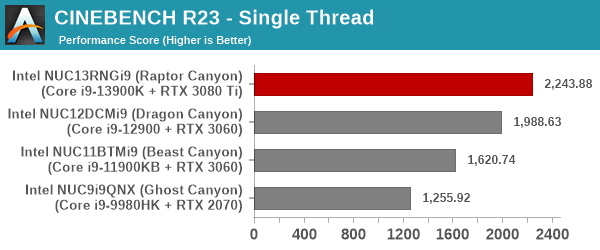
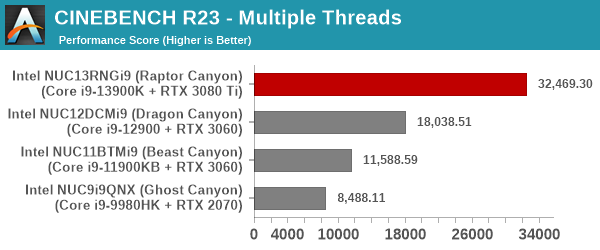
The Raptor Canyon NUC's Core i9-13900K has a huge core-count advantage as well as a much higher PL1 / TDP at its disposal. So, it comes as no surprise that both the single- and multi-threaded benchmarks are dominated by it.
Transcoding: Handbrake 1.5.1
Handbrake is one of the most user-friendly open source transcoding front-ends in the market. It allows users to opt for either software-based higher quality processing or hardware-based fast processing in their transcoding jobs. Our new test suite uses the 'Tears of Steel' 4K AVC video as input and transcodes it with a quality setting of 19 to create a 720p AVC stream and a 1080p HEVC stream.
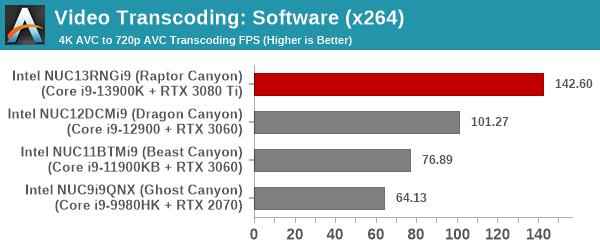
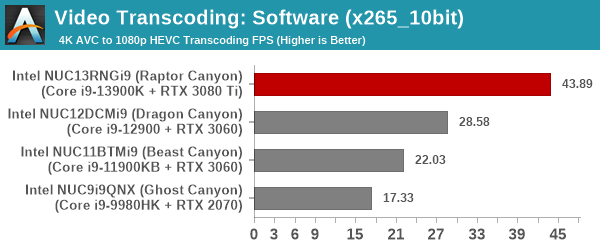
Software transcoding is well-served by the large number of cores as well as high clock-speeds / power budget. No surprises are in store in the x264 / x265 benchmarks.

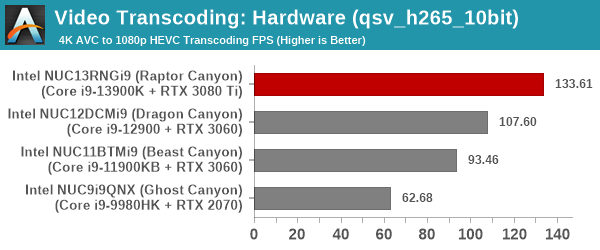
The Raptor Canyon NUC allows use of the QuickSync transcoding engine in the Intel UHD 770 iGPU even without any display connected to it. Higher power budgets allow the iGPU to operate with higher throughput in the Raptor Canyon NUC compared to the Dragon Canyon NUC, even though they both have essentially the same iGPU architecture.
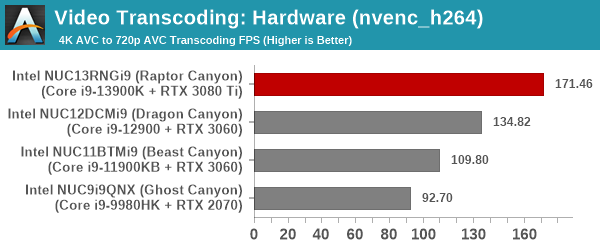

The 'nvenc' transcoding rates are graphed separately and can't be compared with the QuickSync results since the quality and size of the resultant files are different. However, within themselves, we see the RTX 3080 Ti being better than the RTX 3060, which is in turn better than the RTX 2070 - all as expected.
Archiving: 7-Zip 21.7
The 7-Zip benchmark is carried over from our previous test suite with an update to the latest version of the open source compression / decompression software.
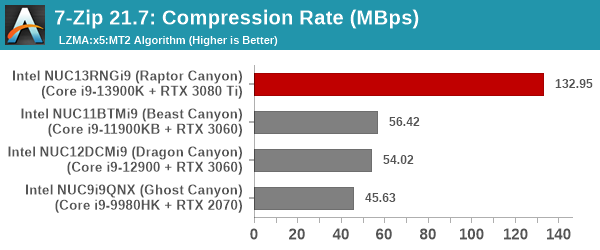

7-Zip performance scales well with the number of cores, as well as the clock rate. This is clearly seen here with the Raptor Canyon NUC ending up with a significant lead over other systems.
Web Browsing: JetStream, Speedometer, and Principled Technologies WebXPRT4
Web browser-based workloads have emerged as a major component of the typical home and business PC usage scenarios. For headless systems, many applications based on JavaScript are becoming relevant too. In order to evaluate systems for their JavaScript execution efficiency, we are carrying over the browser-focused benchmarks from the WebKit developers used in our notebook reviews. Hosted at BrowserBench, JetStream 2.0 benchmarks JavaScript and WebAssembly performance, while Speedometer measures web application responsiveness.
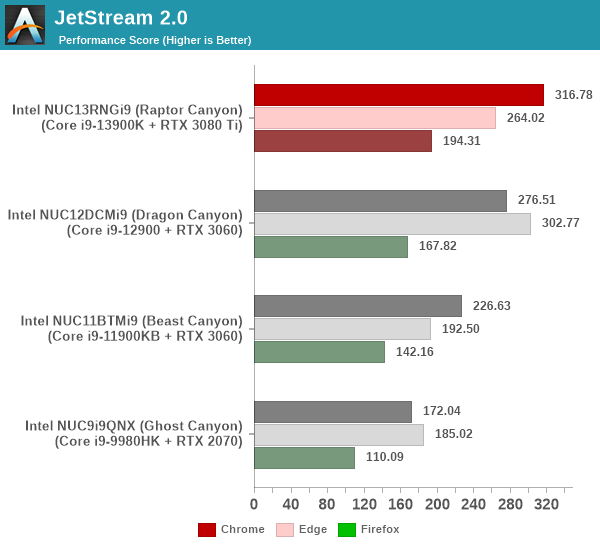
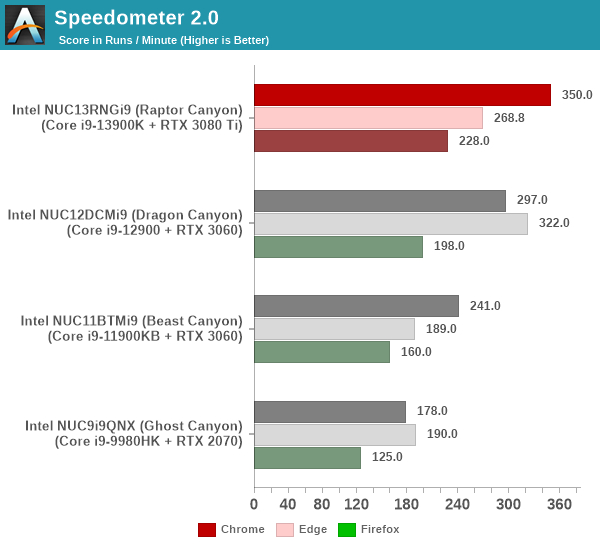
From a real-life workload perspective, we also process WebXPRT4 from Principled Technologies. WebXPRT4 benchmarks the performance of some popular JavaScript libraries that are widely used in websites.

While the performance of Chrome in all three benchmarks is as expected - the Raptor Canyon NUC performing best, with each NUC generation being better than the previous one, Microsoft Edge surprisingly performs better on the Dragon Canyon NUC compared to Raptor Canyon.
Application Startup: GIMP 2.10.30
A new addition to our systems test suite is AppTimer - a benchmark that loads up a program and determines how long it takes for it to accept user inputs. We use GIMP 2.10.30 with a 50MB multi-layered xcf file as input. What we test here is the first run as well as the cached run - normally on the first time a user loads the GIMP package from a fresh install, the system has to configure a few dozen files that remain optimized on subsequent opening. For our test we delete those configured optimized files in order to force a 'fresh load' every second time the software is run.
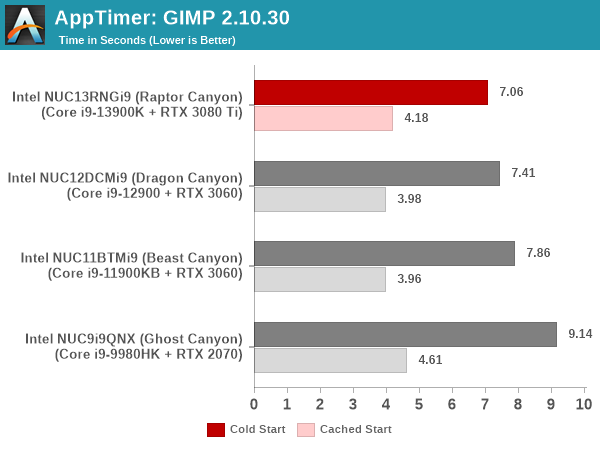
As it turns out, GIMP does optimizations for every CPU thread in the system, which requires that higher thread-count processors take a lot longer to run. So the test runs quick on systems with fewer threads, however fast cores are also needed. The net result is that the Raptor Canyon's cold start times are the best. However, with caching involved, the lower thread-count systems turn out to be slightly better.










27 Comments
View All Comments
DannyH246 - Friday, December 16, 2022 - link
Only if its Intel.TheinsanegamerN - Monday, December 19, 2022 - link
Nah the guy's house burnt down two years ago and there is LITERALLY nothing that anandtech could have done in 2 years to fix that.Bik - Tuesday, December 20, 2022 - link
I miss Ian gpu and Andrei mobile reviewsOxford Guy - Tuesday, December 20, 2022 - link
Size should fit the use case — aka diminished returns exist.DanaGoyette - Wednesday, December 21, 2022 - link
Does this happen to have ECC and vPro support? If so, that (combined with Thunderbolt 4) is already something most self-built machines can't do.missingno - Sunday, December 25, 2022 - link
Intel would burn down their own fabs before they ever put ECC support in their desktop boardshd-2 - Tuesday, January 3, 2023 - link
This thing has been absolutely awesome to play with...using a 7900 XT fits the TDP quite nicely and I'm getting 3x the performance of a computer that had 5x the volume (upgrading from first gen ThreadRipper/Titan build). I'm sure I'll be labelled an Intel shill for saying it, but after seeing a bunch of negative comments I figured I'd post a positive counter.